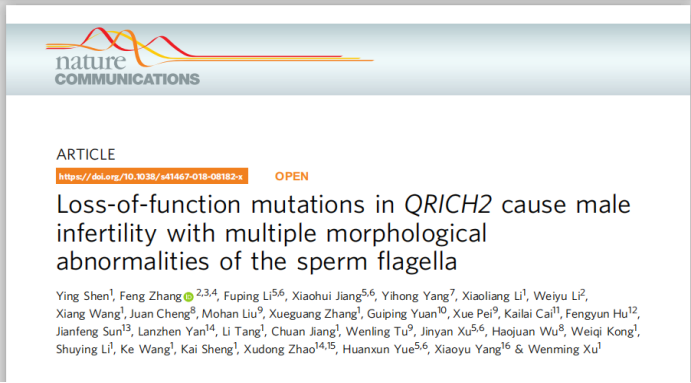In human reproduction, male germ cells, under the chemotaxis in female genital tract, voluntarily swim until binding with the egg cells. Consequently the oosperms are formed, which indicates the beginning of life. The flagellum of human sperm is the primary structure that leads to spontaneous motions of a sperm. What is the initial stage in the flagella formation? The major proteins in the formation of this structure are closely related to the development of human sperm flagellum. However, the molecular mechanism still remains unclear. A recent Nature Communications paper Loss-of-function Mutations in QRICH2 Cause Male Infertility with Multiple Morphological Abnormalities of the Sperm Flagella has unraveled this mystery. These findings are the result of a cooperative research under the supervision of Professor Wenming Xu of Western Institute of Maternal and Child Medicine and Professor Huanxun Yue of Human Sperm Bank of WCSUH, Sichuan University. The first author of this paper is the post-doctoral fellow Ying Shen. Professor Wenming Xu and Professor Huanxun Yue are corresponding authors of this paper.

The study was derived from the discovery in the andrology clinic of our hospital of infertile males in consanguineousmating families of ethnic minorities in Southwest China. Through whole exomesequencing, the authors identified a candidate gene QRICH2 crucial for flagella development in sperm tail. The whole exon sequencing revealed a nonsensemutation (c.192G>A.p.L64*) in exon 3 and a nonsense mutation (c.3037C>Tp.R1013*) in exon 4 of QRICH2 in male infertility of the consanguineous marriage, and both mutations led to the phenotype of multiple morphological abnormalities of the flagella (MMAF). Subsequently, a Cas9 knockout mice model was established. In quantitative proteomics experiments, remarkable down-regulated proteins related to the development andenergy me-x-tabolism of flagella in sperm tail were found in QRICH2 knockout mice. The study also revealed that QRICH2 could regulate the ex-x-pression of ODF2, which was known as a pivotal protein for stabilizing tubulin development in regulation of sperm motility. Further mechanism research found that QRICH2 was a master switch for the ex-x-pression of flagellar key proteins in sperm tail, regulating the ex-x-pression of AKAP3 and CABYR at the levels of transcription and translation respectively. The quantitative proteomic results also indicated the key role of QRICH2 in sperm flagella development. Moreover, the distribution of QRICH2 in sperm tail flagella was observed under high-resolution microscope, and its location was clarified in flagella development. These studies further demonstrated that QRICH2 played a vital regulatory role in the development of sperm fibrous sheath.

It is worth mentioning that this study is the result of close collaboration between basic research and clinical practice. Using the family samples provided by the human sperm bank, the research team has conducted linkage analysis, gene knockout and multi-function analysis. Meanwhile, the team co-operated with Professor Xudong Zhao of Kunming Institute of Animal Sciences, Chinese Academy of Sciences, Director Feng Zhang of Human Sperm Bank in Fudan University and National Key Laboratory of Reproductive Medicine, Nanjing Medical University. After intensive studies, they have revealed a key gene for sperm motility. Moreover, the research team has discovered heterozygousmutations that possibly have pathological significance in 5% of asthenospermia (the most common cause of male infertility) samples, which provides a potential key target for genetic diagnosis of male infertility.
The full article link:https://www.nature.com/articles/s41467-018-08182-x
